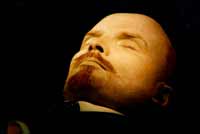Communists worship only ten percent of Lenin’s embalmed body
State Duma deputy Vladimir Medinsky is certain that the Russian authorities have at least four highly serious reasons to bury the body of Vladimir Lenin, the mummy of which is currently resting in Lenin’s Tomb on Moscow’s Red Square.

“Let us not deceive ourselves with illusions of preserving Lenin’s body at Mausoleum. There is only ten percent of his body resting there,” the official said.
Medinsky believes that there is absolutely no need in keeping the embalmed body of the leader of the Great October Revolution in his tomb.
“The location of the ideological artifact in the center of Russia’s capital is an immoral act which is also pointless from the point of view of budgetary spending. It is harmful from the ideological point of view and brutal towards Lenin’s relatives and those people who do not share the communist ideology,” Vladimir Medinsky said at today’s press conference in Moscow.
“The only aspect that justifies the authorities is their unwillingness to touch a raw nerve. They hope that the controversy connected with the preservation of Lenin in Mausoleum will fade away itself,” the deputy said.
However, the official believes that it may not happen.
“The communist electorate, who votes for communists at elections, becomes younger with every year. This is not just a Russian, but a global trend. That is why it will be difficult to avoid decisive measures at this point,” Medinsky said.
Dr. Vladimir Lavrov, deputy director of the Institute of Russian History, who also appeared at the above-mentioned press conference, said that the necropolis on Moscow’s Red Square should to be liquidated, whereas Lenin’s and Stalin’s remnants should be handed over to relatives.
“I believe that it will happen sooner or later,” Lavrov said.
On January 21, the day that Lenin died, the Soviet government received more than 10,000 telegrams from all over Russia, which asked the government to preserve his body somehow for future generations. On the morning of January 23, Professor Alexei Ivanovich Abrikosov—a prominent Russian pathologist and anatomist (not to be confused with physicist Alexei Alexeyevich Abrikosov, his son)— embalmed Lenin's body to keep it intact until the burial. On the night of January 23, architect Aleksey Shchusev was given a task to complete within three days: design and build a tomb to accommodate all those who wanted to say their goodbyes to Lenin. On January 26, the decision was made to place the tomb at the Red Square by the Kremlin Wall. By January 27, Shchusev built a tomb out of wood and at 4 p.m. that day they placed Lenin's coffin in it. More than 100,000 people visited the tomb within a month and a half. By August of 1924, Shchusev upgraded the tomb to a bigger version. The architect Konstantin Melnikov designed Lenin's sarcophagus.
In 1929, it was established that it would be possible to preserve Lenin’s body for a much longer period of time. Therefore, it was decided to exchange the wooden mausoleum with the one made of stone (architects Aleksey Shchusev, I.A. Frantsuz, and G.K. Yakovlev). They used marble, porphyry, granite, labradorite, and other construction materials. In October 1930, the construction of the stone tomb was finished. In 1973, sculptor Nikolai Tomsky designed a new sarcophagus.
On January 26, 1924 the Head of the Moscow Garrison issued an order to place the Guard of Honour at the mausoleum. Russians call it the "Number One Sentry". After the events of the Russian constitutional crisis of 1993, the Guard of Honor was disbanded. In 1997 the "Number One Sentry" was restored at the Tomb of the Unknown Soldier in Alexander Garden.
More than 10 million people visited Lenin's tomb between 1924 and 1972.
Though supposedly "rejuvenated" annually by Russian undertakers, Lenin's body currently gives off a waxed appearance, prompting many to wonder if it is still real. Some parts might be fake, or partially fake for the needs of predictability. Neither the former Soviet government nor the current Russian authorities would comment on the topic of the body's authenticity. The family of Lenin's embalmers states that the corpse is real and requires daily work to moisturize the features and inject preservatives under the clothes. Lenin's sarcophagus is kept at a temperature of 61 degrees and kept at a humidity of 80 - 90 percent. The chemical used was referred to by the caretakers as "balsam", which was glycerine and potassium acetate. Every eighteen months the corpse is removed and goes under a special chemical bath. The chemicals that were unknown until after the fall of the Soviet Union were kept secret by authorities. The bath consists of placing the corpse in a glass bath with potassium acetate, alcohol, glycerol, distilled water, and as a disinfectant, quinine. This was the process used for all subsequent treatments of Lenin's body and continues to be used even now.
One of the main problems the embalmers faced was the appearance of dark spots on the skin, especially on the face and hands. They managed to solve the problem: in between baths the spots were eliminated by the use of a variety of different reagents. For example, if a patch of wrinkling or discoloration occurred it was treated with an acetic acid diluted with water. Hydrogen peroxide could be used to restore the tissues' original coloring. Damp spots were removed by means of disinfectants like quinine or carbolic acid.
The body was removed in October 1941 and evacuated to Tyumen, in Siberia, when it appeared that Moscow might be in imminent danger of falling to invading Nazi troops. After the war, it was returned and the tomb reopened.
Subscribe to Pravda.Ru Telegram channel, Facebook, RSS!

